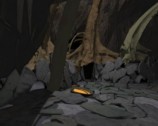The restriction of male and female movement within ceremonial and domestic dwellings appears to have been a critical component of whaling-related ritual in many areas of the Arctic. In Alaska and the northern northwest coast, wives were required to lie motionless on the sleeping platform during whaling expeditions (Lantis 1938, 445-49; Lowenstein 1993, 38-50; Spencer 1959, 338). This may relate to a similar practice in which umialit wives would lie at the edge of the sea ice with their heads oriented toward the community as the whaling crew prepared to embark on its quest (Lowenstein 1993, 40; Rainey 1947, 259). In the Bering Strait region, wives and their husbands participated in a ceremony known as 'the sitting' in which participants sat motionless in the karigi while concentrating on whales (Lowenstein 1993, 114-15; Rainey 1947, 247). Similar practices were carried out in Labrador, where women were required to sit on the sleeping platform cross-legged and motionless during the whale hunt (Taylor 1985, 127).
Lying or sitting motionless on a sleeping platform would have 'fixed' the viewer's attention on particular areas of the dwelling. Figure 6 provides a view from the inside of the scanned whale cranium. A view of the apex of the roof frame, as it would have appeared to someone lying motionless on the sleeping platform, is presented in Figure 7. These two views are strikingly similar and suggest that the sensory experience of lying motionless inside this house would have evoked the concept of whale as iglu portrayed in myths such as the Raven and the Whale.
Among Alaskan whaling societies, kataks and tunnel entrances were occasionally seen as symbolising the spouts of water ejected from the breathing holes of whales (Lee and Reinhardt 2003, 143). Figure 8 is the view of the entrance tunnel as seen by someone sitting on the sleeping platform. The positioning of the middle cranium directly over the entrance tunnel creates the visual impression that the passage is aligned with the whale's blowhole. Thus, to an individual seated on the sleeping platform, the sensory experience evoked by the crania is one in which a person emerging from the tunnel is seen as entering the whale-iglu through its blowhole.

Figure 8: The entrance tunnel as seen by someone seated on the sleeping platform
© Internet Archaeology/Author(s)
University of York legal statements | Terms and Conditions
| File last updated: Wed Sept 27 2005